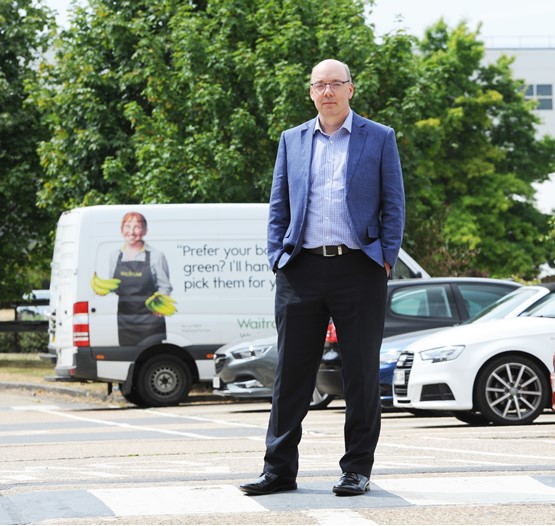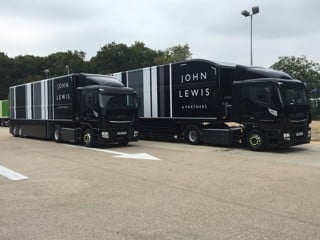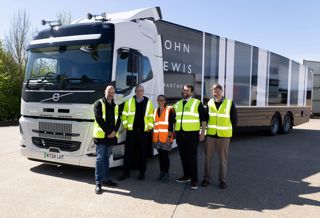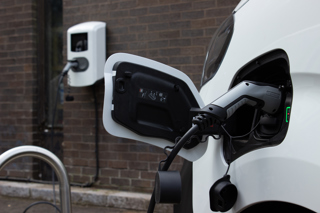
This article originally appeared in the May issue of Fleet News available as a digital edition.
Justin Laney, general manager – fleet at John Lewis Partnership, reveals the impact the Covid-19 crisis has had on JLP. Here, he offers an insight into a typical day in the life of his fleet operation. As told to Matt de Prez.
7am: Start work
Since the start of the lockdown I’ve been working from home and one of the biggest changes for me is that I’m getting a lot more sleep! I used to get up at 5.30am to drive to Bracknell, which is about 45 miles from my house. Now, I get an extra hour in bed before I make my way to my study. The start to my day is certainly a lot easier than it used to be. As always, a check on emails is first thing on my agenda.
7.15am: Check downtime report
I always look at the downtime report at the start of the day. We have a live downtime tracker that shows what proportion of the fleet is off the road at any location.
The John Lewis Partnership is formed of Waitrose, which is very busy at the moment, and John Lewis, which is certainly much quieter as the shops are closed.
The Waitrose home delivery fleet is absolutely key at the moment, as are the trucks that deliver stock to the branches.
Everything that will turn a wheel is working right now within the Waitrose home delivery fleet. If we are short of vehicles in one area, we have a spare vehicle fleet that can be deployed where needed. We also have a ‘mothballed fleet’ of decommissioned vehicles that we can put back into service pretty quickly. That is how we usually get through peak times such as Christmas and it allows us to avoid renting.
8am: Speak to my manager
As we no longer see each other face-to-face, I have a call with my manager every day at 8am – that’s a real brief call to see how things are going and highlight any key issues.
8.30am: Steering group call
My next call is with all of the leadership team within central transport. We have an update on where we are with Covid, including a tracker for how many people are off and when we are expecting them back.
There has been a lot of assistance from within the partnership with regards to John Lewis staff helping out on the Waitrose side. That’s looked after by the operations team – my job is purely about the vehicles and we put the vehicles wherever the business needs them.
We need to discuss the acquisition of new vehicles. The Waitrose home delivery fleet has about 1,000 vehicles now, but we expect that to grow to 1,400 by the end of the year.
We’ve seen a doubling of the Waitrose home delivery business since the coronavirus lockdown, most of that has been accommodated by filling up all the available slots, but we’ll need to expand the fleet this year quite substantially.
Pretty much everything we would be doing normally we are doing, all the major projects are still progressing, including our work to switch the truck fleet from diesel to bio-methane.
11am: Workshop manager call
During the daily workshop managers call that’s when a lot of things such as advice for staying safe in a Covid environment are communicated.
All our heavy trucks and trailers are maintained in the workshops along with some of the home delivery vehicles.
On the heavy trucks, maintenance hasn’t really changed at all. With the vans we have made some adjustments to the maintenance regime on the very newest equipment to increase uptime.
Direct communication with technicians is more difficult. We tried video calls, but it is more difficult in that environment, it’s about making sure the local workshop manager is informed. I was really concerned about what would happen if we had half the workshop off sick with the virus, but we’ve managed to function as normal. In terms of a service, it is pretty normal. We’ve got a lot of separation and PPE (personal protective equipment) to make sure the technicians are safe.
Noon: Lunch and exercise
It’s easy, sit at the computer all day when working from home. When working at Bracknell, the site is huge and it’s easy to clock up steps walking between meetings.
1pm: Workshop visit
I visited our Magna Park workshop in Milton Keynes to ensure they were all satisfied with their PPE and were happy. Workshop people are one step back from the frontline. They aren’t meeting customers, but they still go into work because the trucks have to deliver food to shops – it’s very much a key occupation.
As a food retailer we get some priority over sourcing PPE. Sometimes the PPE destined for us gets diverted to the NHS, but our access is better than an individual workshop.
3.30pm: Team huddle
For home-based workers we have two video huddles per week. In the office, we would usually have one. It gives the chance to share a brief update on what is happening within the department and get the chance to ask questions.
We are prioritising video calls, partly because so much of human communication is non-verbal, but also because for someone working on their own from home it can be very lonely.
Some of these calls have 50 people all on video. That works really well.
Within the teams, if there is something to celebrate, we’ll do that within the huddle. It is always good to celebrate good stuff.
5pm: Virtual drinks with colleagues
Every Friday the company hosts virtual drinks with a quiz. It brings everyone together on a social level and is good fun.
You can read the article in the May issue of Fleet News, by clicking here
In the last of our frontline fleets, Graham Telfer explains how local authorities have ‘stood up to the test’ by ensuring vital services have been maintained, and refuse collection driver Tony Robinson tells how his crew is overcoming the restrictions imposed by social distancing.
Keep up to date with Covid-19 news and guidance
For the latest commercial fleet guidance on Covid-19, click here
For the latest commercial fleet-specific Covid-19 news, click here
The FTA and CILT have launched a coronavirus good practice guide, access it here


















Login to comment
Comments
No comments have been made yet.